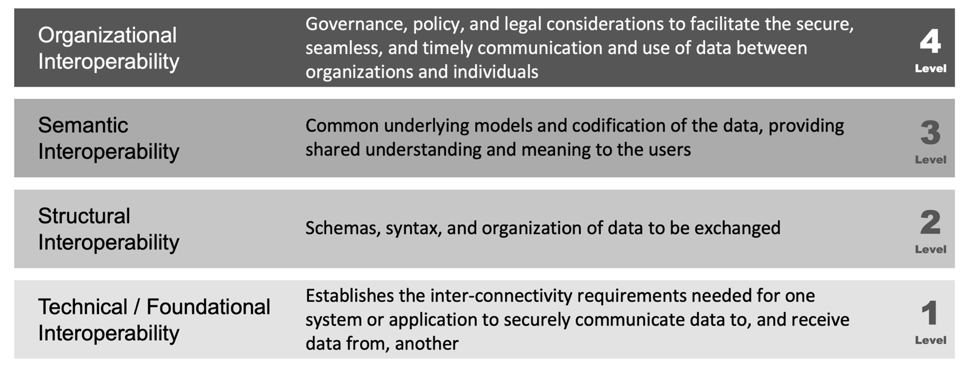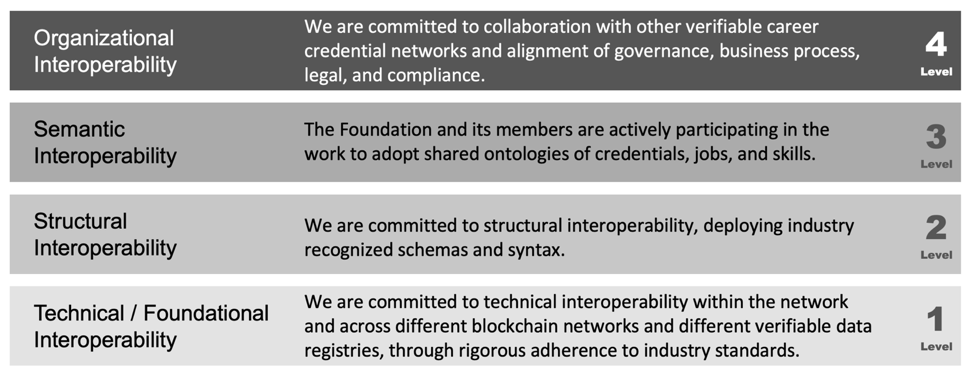Velocity is designed to be the world’s network for verifiable and trusted career credentials, built for the digital age.
Signed credentials are issued by businesses, education providers and government agencies to individuals, attesting to their education and career achievements, and stored on the individual’s device with their sole ownership and control. Cryptographic proof of validity is stored on an immutable, high-performance blockchain.
These individuals can now choose whether and with whom to share selected credentials. Any permitted recipient of a credential and check against the blockchain for its validity.
Reducing friction and the cost to transfer trusted career and education credentials will be the ‘great transformer’ of the global labor market, redefining human capital development and deployment.
Interoperability within the Internet of Careers
A verifiable career credentials platform is by all definitions a multi-sided platform. On one side are the Holders, individuals who want to own and control their career credentials, privately store them, and share them at their discretion, to access better career and education opportunities. On the other side are the Issuers, who issue credentials to the individuals, asserting their career records, as well as the Verifiers, the organizations to whom the individuals will present the credentials.
The world of work will be mired in Babel forever until platforms talk to each other. That’s interoperability: in the context of self-sovereign career identity, interoperability is the ability of different actors in the labor market and education spaces to issue, revoke, share and verify credentials, and cooperatively use them in a coordinated manner, within and across different systems, tech environment, and verifiable data registries.
The intents of interoperability are two: drive ubiquity and mitigate vendor lock-in. Ubiquity means all the different career credential-oriented systems and applications (‘CCO apps’) will be able to access, exchange, integrate and cooperatively use data in a coordinated manner, within and across organizational, regional and national boundaries. The vendor lock-in problem in computing is the situation where users are dependent (i.e., locked in) on a single provider technology implementation and cannot easily move to a different vendor without substantial costs or technical incompatibilities. Interoperability and industry-wide standards will minimize users’ cost and friction swapping out technology providers.
Out with the old, and in with the interoperability.
A holistic approach to interoperability
Many organizations are working to develop and implement industry-wide technical standards across the education space and the world of work, to tackle this challenge of interoperability.
Technical standards are a critical aspect of Interoperability, but they’re just the start. Truly functional interoperability requires a more holistic, thorough approach. To really work, interoperability has to address four layers: technical/foundational, structural, semantic, and organizational.

Of the above four layers, the most difficult to resolve is organizational interoperability, composed of legal interoperability and business process interoperability.
Legal interoperability
Each participant in the career credentials ecosystem works within its own national legal framework (e.g., employment, privacy). Legal interoperability is about ensuring that organizations and individuals that operate under different legal frameworks, policies, and strategies are able to work together.
Ideally, this can be resolved through appropriate, global cross-border legislation. This is obviously not realistic, and there are no existing precedents for a global framework that is effectively implemented and maintained.
A more realistic route would be to resolve this through clear agreements signed by the different participants, to ensure operational consistency and legal clarity for every transaction.
Business process interoperability
Typically, the career records of any given person are processed by various siloed authorities: past employers, governments, licensing bodies, education and life-long learning providers, staffing and contingent work organizations, to name a few. For all these different entities to be able to efficiently provide information that conveys the full picture of this person’s career profile, they must all align their processes—or define and establish new ones. This way, they can avoid a broken experience for the individuals or organizations requesting access to such records and prevent use cases from being inadvertently excluded.
Velocity Network is committed to interoperability

Technical standards are just the beginning. They are not enough to achieve thorough interoperability, and furthermore, interoperability is not enough to drive ubiquity.
Standards do have the potential to drive cross-blockchain network interoperability for Levels 1 through 3. However, Level 4, organizational interoperability, can only be achieved through alignment on governance, business process, legal, and compliance. This will be extremely difficult to achieve.
Moreover, interoperability is important to prevent vendor lock-in, but we don’t think it is what will play a key role in driving broad adoption—incentive structure will.
As the White Paper on Interoperable Learning Records[i] (ILR) clearly states, “Each employer participates in the system not only by using ILRs for hiring, but also by issuing credentials to employees for their accomplishments in workplace skills, training, and compliance. There are obvious incentives for employers to do the former, but the incentives for employers to report and verify their employees’ skills are less clear. (…) Balancing the incentives to participants is important to ensure widespread and scalable adoption.”
In addition, the verifiable credentials framework disrupts profitable money-making services for many of the participants that currently generate revenue every time they issue a transcript, diploma, or license. To gain adoption from these actors, there must be an alternative monetary incentive to replace these revenue streams.
What the Velocity Network isn’t—and what it is
- The Velocity Network is NOT a tech stack. We do develop open-source, royalty free, standard-compliant, interoperable software components that can be used by participants to issue, revoke, share, and verify career credentials, but we accommodate any other software that adheres to industry standards.
- The Velocity Network is NOT a standards organization. We do encourage members and participants to engage in standards setting, but we are following industry standards to maintain cross-network interoperability, and not setting standards independently.
- The Velocity Network is NOT a Software, Platform, Infrastructure, nor Blockchain as a service (SaaS, PaaS, IaaS, BaaS). Velocity Network stewards are running consensus network nodes and provide the network with componential power, but this is not the core of what we do, and the Foundation may decide to move to a public blockchain further down the road.
- The Velocity Network is a democratic, collaborative governance construct that enables Level 4 Interoperability for its participating entities, ensuring operational consistency and legal clarity for every transaction.
- The Velocity Network is an incentive structure that drives desired participant behaviors, and a value transfer system between the demand side and the supply side in the global labor market.
[i] American Workforce Policy Advisory Board’s Data Transparency Working Group, White Paper on Interoperable Learning Records, U.S. Department of Commerce, September 2019. https://www.commerce.gov/sites/default/files/2019-09/ILR_White_Paper_FINAL_EBOOK.pdf, Retrieved December 21, 2020.
Photo by Christina Morillo from Pexels